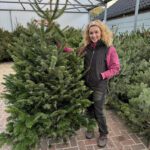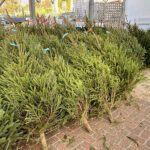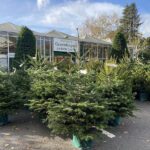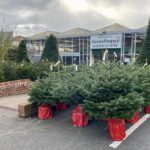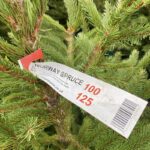At Greenfingers, we pride ourselves on selling a wide range of different-sized real Christmas trees every year for the festive season. These beautiful trees are an important part of the festive period as they become highly decorated centre-pieces of the house. So this is our guide for both new and experienced buyers to help you decide which tree is best for you.
Cut Nordmann and Norway Spruce
Nordmann and Norway Spruces are the two types of Christmas trees available at Greenfingers (and these are the most commonly used). The main differences between two is that Nordmann Spruces don’t drop their needles as readily as Norway Spruces, however Nordmanns don’t have the traditional “Christmas tree smell” like their classic Norway counterparts. Let’s look at the positives and negatives of both types:
Nordmann
Britain’s most popular Christmas tree, the Nordmann is a fantastic choice, it’s the more expensive of the two, but the price is a reflection of the quality and the favourable non-drop needles.
The tree itself has gorgeous foliage, cone-shaped, open spiky branches with long, glossy dark green needles and a luscious silvery bark.
Pros:
- Soft foliage
- Non-drop needles
- Will stay fresh for a long time as long as its watered
- Has a fuller feel to the tree with less gaps than the Norway
Cons:
- More expensive than the Norway
- Doesn’t have the “Christmas tree smell”
Norway Spruce
The more traditional of the two, the Norway Spruce gives you a very classic Christmas tree feeling in both sight and smell; it is also cheaper than the Nordmann. Norways have short needles that are a light green and slightly sharper than those of the Nordmann.
Pros:
- Smells strongly of spruce (the Christmas tree smell)
- Cheaper than the Nordmann
- Traditional Christmas Tree
Cons:
- More prone to dropping needles – regular monitored watering will keep it healthy for longer.

Caring for your Christmas Tree
The secret of long lasting Christmas trees is proper care, as this will reduce needle drop dramatically. Below are top tips to keep your Christmas tree looking happy and healthy throughout the festive period.
- Buy as late as your dare – this means that the tree is looked after by us in optimum conditions for the longest amount of time. As well as this, when you get your cut tree, leave it outside in a small container of water for as long as you can. This keeps the tree fed and in the correct temperature conditions for as long as possible (you should expect your tree to stay at its best indoors for a maximum of two weeks).
- Take the netting off as soon as you get home – this prevents the tree from sweating and therefore prevents it from heating up and dropping needles.
- Pick the right spot – Stand your tree in a cool area of the house well away from heating such as radiators, again this is to prevent needle drop and keep your tree at its best for longer.
- Keep your tree watered – Water regularly and don’t let it dry out; but don’t leave it sitting in water. You can water your tree by placing it in one of our tree stands we sell at Greenfingers (plastic and metal options available).
Potted Christmas Trees
Looking for something longer lasting that you can keep for after Christmas and many Christmas to come? A potted Christmas tree could be the option for you!
These are the most expensive option and have spent their lives in a pot. However, after Christmas, they will flourish in your garden when planted, or (the most often used method) they can be grown in the pot year after year. Please be warned that a planted Christmas tree will eventually grow to a very large size and many are too big for most gardens. So, keeping the tree in the pot year after year is a safer and easier choice. Similarly to the cut trees, we have both Norway and Nordmann options available.
Caring for your Potted Christmas Tree
Proper care of a Christmas tree is crucial to its success and it’s no different when it comes to potted Christmas Trees. Below are some guidelines for caring for your potted Christmas tree over the festive period.
- Timing – Keep your tree indoors for no more than two weeks. You can keep your tree in a sheltered spot outside until you’re ready to bring it in, like a shed (that has light) or a conservatory.
- Pick the right spot – Choose a cool spot, away from radiators and fires, to prevent the tree from overheating. It should have some natural daylight for it to continue to grow and thrive.
- Place a saucer under the pot to protect your floor/carpet, or place the pot inside another one without drainage holes. We recommend a saucer as water monitoring is easier and more successful this way.
- Keep your tree watered – similarly to the cut trees, you will need to water your potted tree regularly to ensure it remains happy and healthy, they will not need as much water as cut trees and it is crucial not to over water.
- Try using ice cubes – Ice cubes in water if you are using a saucer will help keep the roots cool, this is however not essential.
- LED lights – Decorate your tree with LED lights to prevent your tree from being burnt.
After Christmas – What to do with your Christmas Tree
Cut trees are sometimes collected by local council services or even charities for a small fee – so make sure to do your research if you wish for this to be done for you. Alternatively, you can take your cut Christmas tree to your local recycling centre as it can be recycled in the garden waste section.
Potted Christmas trees stay with you so there are two main options when it comes to what to do with them after Christmas. Trees in pots can be planted in the garden, though bear in mind as previously mentioned they will grow far too big for most gardens.
Alternatively, they can be kept in their pot and grown outside until Christmas. Every year, remove the top layer of old compost in spring and put in fresh compost mixed with a slow-release feed. Water whenever the surface of the compost feels dry.

